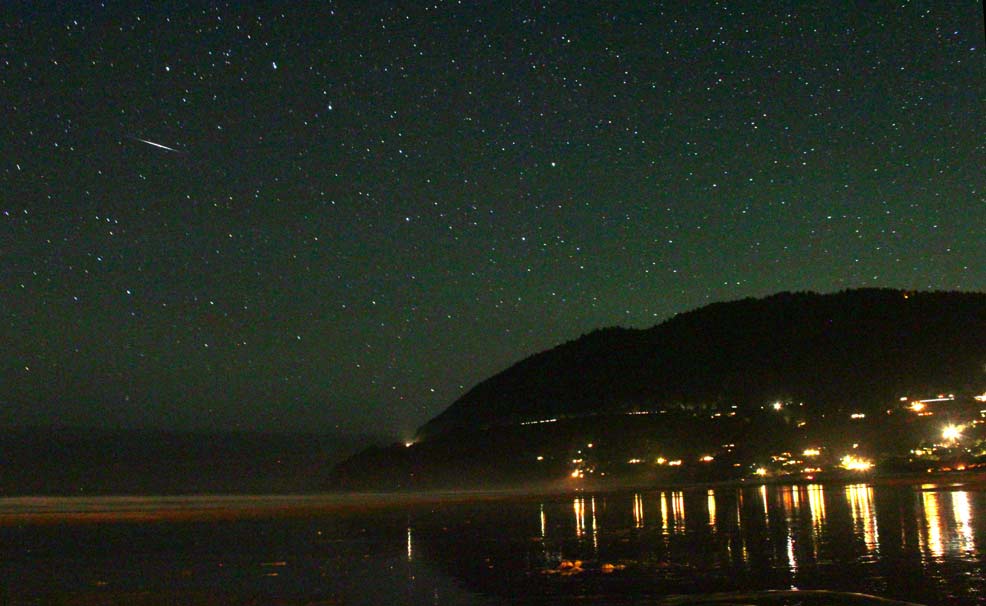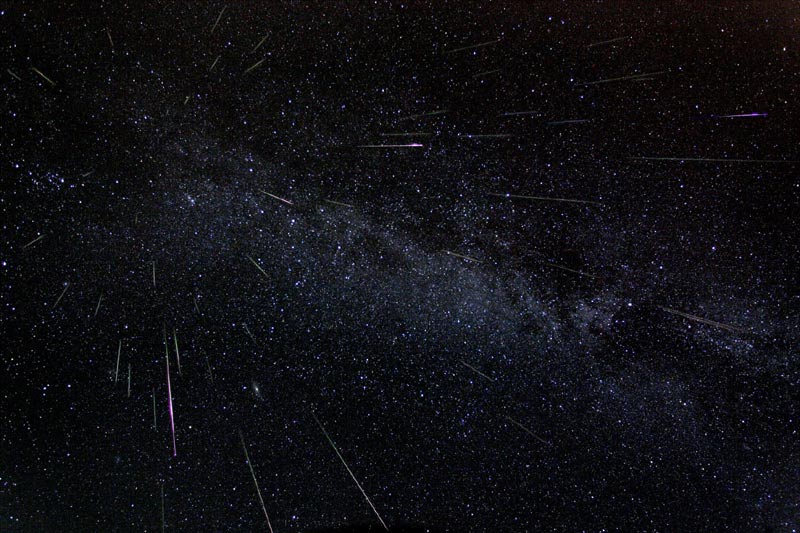60 or More Meteors Per Hour Next Week for Oregon, Washington Coast
Published 08/06/20 at 6:24 AM PDT
By Oregon Coast Beach Connection staff

Includes exclusive listings; some specials in winter
In Cannon Beach:
Includes rentals not listed anywhere else
In Manzanita, Wheeler, Rockaway Beach:
Some specials for winter
In Pacific City, Oceanside:
Some specials for winter
In Lincoln City:
Some specials for winter
In Depoe Bay, Gleneden Beach:
Some specials for winter
In Newport:
Look for some specials
In Waldport
Some specials for winter
In Yachats, Florence
Some specials for winter
(Portland, Oregon) – From the tips of the southern Oregon coast at Brookings to the edges of the Olympic Peninsula on the Washington coast, nightly fireworks have begun.
The 2020 Perseid meteor shower has arrived, and like the rest of the world the Pacific Northwest will get to see the peak on the mornings of August 11, 12 and 13. Even now you can see some darting across the sky, and the lack of street lights along the shorelines of Washington and Oregon will be providing some of the best views – weather and sea mist conditions permitting. They began in late July and will be around until August 24.
According to OMSI astronomy expert Jim Todd in Portland, the Perseids are some of the brightest meteor showers of the entire year, with their peak next week showing off dozens per hour.
“The waning crescent moon will slightly temper this year’s production,” Todd said. “Still might see up to 40 to 50 meteors per hour at the shower’s peak.”
Todd said it’s made up of tiny space debris from comet Swift-Tuttle, and they’re named after the constellation Perseus because that’s where they appear to radiate from.
“The Perseids are widely sought after by astronomers and stargazers because most years at its peak, one can see 60 to 100 meteors in an hour from a dark place,” he said.
Indeed, some of the darkest places are along the coasts of Washington and Oregon. More remote beaches up around Raymond, the Long Beach Peninsula, south of Cannon Beach, or just north or south of Gold Beach will be not only bereft of light but spectacular ocean vistas at night.
Todd said the evening of August 12 will likely provide the best chance, if things are clear. The peak is actually surprisingly broad, so it’s advisable to keep looking just before and just after that date. You’ll find most of the meteors about 50 degrees from the “radiant,” which is between Perseus and Cassiopeia.
“Start watching on the evening of the 12th as soon as it darkens and the radiant near the Double Cluster in Perseus clears the horizon after midnight,” he said.
If you can’t make it to the beach, those in larger cities like Seattle, Olympia, Portland, Salem or Eugene should simply get to a darker spot in the nearby countryside.
Indeed, Oregon Coast Beach Connection employees have already seen some in the skies, even including within Portland.

Meteors photo courtesy NASA
If you’re going to head out in the early evening, be outside when the first stars start to appear, which is a bit after 9 p.m. these days. At that point, Todd said, the radiant will be low in the northeast, which may cause some blocking of Perseid itself for those looking from the coastlines of either Oregon or Washington. However, Todd said the shooting stars themselves actually dart in from all kinds of directions, not just the radiant.
In fact, wherever you are, either on the coast or not, the best streaks will happen elsewhere in all kinds of random places.
“Don't concentrate just on that one area but rather let your gaze wander over a large portion of the sky,” Todd said. “Meteors that appear near the radiant will have short paths while those that begin farther out have much longer ones. As the hours pass the radiant rises higher and between about midnight and dawn the greatest number of meteors can be seen.”
Todd said these Perseids are extremely fast and tend to be fairly bright at a magnitude of -1. Every once in awhile you’ll get to see a serious fireball.
“Every year, Earth passes through debris paths left by comets as they hurtle past the Sun,” Todd said. “The results of these intersections are called meteor showers when the tiny bits of debris burn up in Earth’s atmosphere. We see them as bright streaks across the night sky and name them ‘shooting stars,’ intense streaks of light across the night sky.”
Those streaks are made of little bits of interplanetary rock and debris called meteoroids that crash and burn at a high rate of speed in Earth’s upper atmosphere. They’re going thousands of miles per hour, Todd said, igniting instantaneously in the friction the atmosphere creates, burning out anywhere from 30 to 80 miles above the ground. The vast majority are destroyed during entry. Those extremely rare few that don’t and actually hit the ground are known as meteorites.
“Of these annual intersections, the Perseid Meteor Shower is the most well-known,” Todd said. “This meteor shower occurs when the Earth enters a debris path left by the comet Swift-Tuttle during its last trip past the Sun in December 1992. As comets orbit the Sun, they shed an icy, dusty debris stream along the comet's orbit. If Earth travels through this stream, we will see a meteor shower. Depending on where Earth and the stream meet, meteors appear to fall from a particular place in the sky known as the radiant. In the case of the Perseid meteor shower, the radiant takes place in the constellation Perseus.” See Oregon Coast Weather - Washington Coast Weather
Oregon Coast Hotels for this event - Where to eat - Map - Virtual Tour
Cannon Beach Lodging
Nehalem Bay Lodgings
Manzanita Hotels, Lodging
Three Capes Lodging
Pacific City Hotels, Lodging
Lincoln City Lodging
Depoe Bay Lodging
Newport Lodging
Waldport Lodging
Yachats Lodging
Oregon Coast Vacation Rentals
Oregon Coast Lodging Specials

More About Oregon Coast hotels, lodging.....
More About Oregon Coast Restaurants, Dining.....
LATEST Related Oregon Coast Articles
Through 2 a.m. likely best, but some lights possible through dawn June 1 - 2. Space weather, astronomy
Rare Sperm Whale Stranding on N. Oregon Coast, Was Hit by Boat
Showing up near Gearhart, it will decompose naturally. Marine sciences
Coast Guard Barque 'America's Tall Ship' Coming to Portland Rose Fest, N. Ore...
Portland events: June 5 - 8; Astoria events June 13 - 15. Weather
Bright and Active Arietids Meteors May Hit Pre-Dawn Hours of Oregon, Washingt...
Look to east hour before sunrise and you may catch a show. Sciences, astronomy, weather
Why Now Could Be a Great Week for Spotting Killer Whales on Oregon Coast - Video
A good dozen documentations around Depoe Bay, Newport, Coos Bay, Bandon, Tillamook. Marine sciences
Summer Road Work, Traffic Issues Along Oregon Coast Include Astoria, Garibald...
Some daylight closures include bridges, OR 22, OR 18, OR 26, more. Travel tips. Seaside, Cannon Beach, Lincoln City. Travel tips
Pacific City Oregon Weather, 7-Day Forecasts, Live Conditions, Radar, Webcams...
Updated Constantly: Pacific City, Tierra Del Mar, Oregon Weather, Cams, Buoy Observations, Tides, Warnings - Alerts
Oregon Coast Has World's Oldest Harbor Seal, Celebrating 50 Years Soon
June 3 at Oregon Coast Aquarium in Newport. Newport events
Back to Oregon Coast
Contact Advertise on BeachConnection.net
All Content, unless otherwise attributed, copyright BeachConnection.net Unauthorized use or publication is not permitted















































